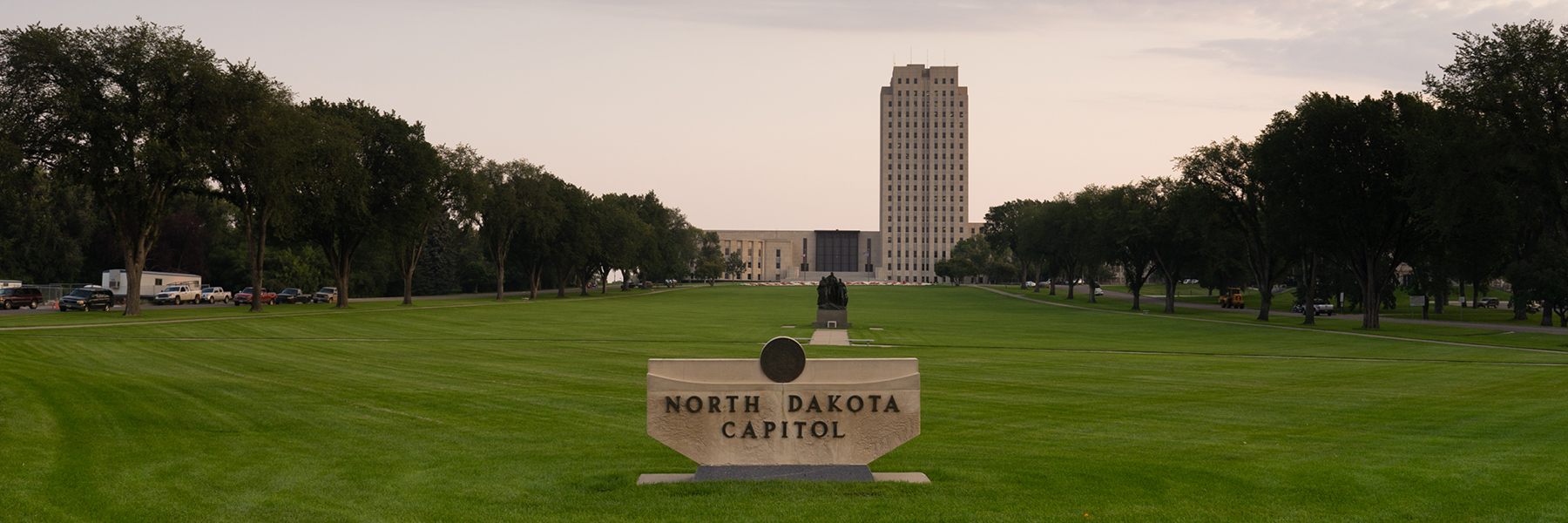2025 Legislative Session: Children’s Well-Being Bills
June 2025
North Dakota recently wrapped up the 69th Legislative Session with more than 1,000 bills introduced.1 The biannual legislative session is critical for many policies and programs that support children and families. Ultimately, we elect legislators to work on policies and draft a state budget that represents collective priorities across the state. North Dakota legislators were tasked with passing a $20.3 billion budget for the 2025-2027 biennium starting this July.2 Overall, North Dakota’s 2025-2027 budget is bigger than the prior biennium (growing 3.3 percent from $19.6 billion in 2023-2025).3
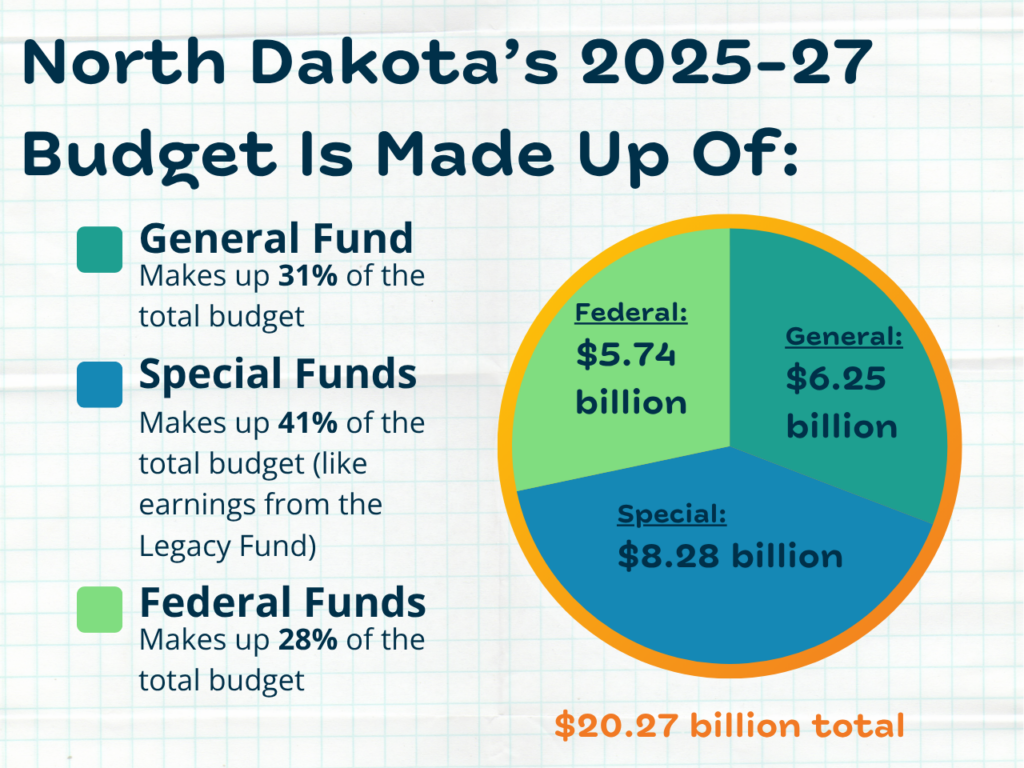
The two state agencies that house the largest share of funding impacting children are the Department of Health and Human Services and the Department of Public Instruction.
Department of Health and Human Services (DHHS):
North Dakota’s Department of Health and Human Services oversees a wide range of programs that support public health and safety across the lifespan, such as direct assistance programs for food, child care, and health insurance, maternal and child health programs, birth and death data, and behavioral health programs including the Regional Human Service Centers. Overall, the DHHS budget for the 2025-2027 biennium totals nearly $5.8 billion, a 9 percent increase from the previous biennium.4,5 The DHHS budget moved through the legislative process in House Bill 1012.
House Bill 1012 | Amendment Descriptions
Notable changes in the DHHS budget related to children and families include:
- A total one-time appropriation of $21.9 million to support early childhood education and child care, including $4 million to expand the Best-in-Class preschool program, $1.5 million for the Waterford Upstart (overall a decrease from the $2.4 million to this program last biennium), $7.8 million to support child care programs related to infrastructure, quality, and support for special needs children, and $11 million to support child care programs providing infant and toddler care. An additional $21.6 million was included in the budget to continue the changes implemented last session for the Child Care Assistance Program.6
- $5.6 million related to post-adoption services and child welfare support.
- $1.8 million to support youth behavioral health, including expanding an education treatment collaborative for traumatized youth and funding for out-of-home residential services for Medicaid-eligible children with serious emotional disorders.
- $300,000 toward grants that support crisis services for young adults at risk of homelessness.
- $4.9 million to design the children’s cross-disability waiver for Medicaid, split between both federal and state funds. This waiver aims to address existing disparities in access to home and community-based services for children with disabilities.7
- A one-time appropriation of $750,000 to support juvenile justice diversion services and programs and create a task force.
- A rate increase of 2 percent each of the next two fiscal years for all human service providers.
- The Children and Family Services Section was underfunded by $18 million over the biennium, split between federal and state funds.8 This underfunding was based on foster care caseload trends, which are expected to continue to decrease. However, some policy bills (see House Bill 1072) will likely lead to an increase in foster care caseload and funding.
Department of Public Instruction (DPI):
North Dakota’s Department of Public Instruction oversees public schools and education-related programs for preschool through 12th grade students. Overall, the DPI budget for the 2025-2027 biennium totals $3 billion, a 6 percent increase from the previous biennium.9,10 The DPI budget moved through the legislative process in House Bill 1013.
House Bill 1013 | Amendment Descriptions
Notable changes in the DPI budget include:
- $6 million in one-time funding over the biennium to cover the cost of school meals for families at or below 225 percent of the poverty level (about $60,000 for a family of three).
- $150,000 increase in operating expenses to administer the Summer EBT program, which provides families with school-age children access to additional food assistance during the summer months.
- $950,000 in one-time funding to support expenses related to the Native American Essential Understandings, including the cost of printing a textbook series on Native American history.
- $300,000 to support a summer program that encourages Indigenous youth to attend STEM programs.
In addition to passing policies and a budget that reflects priorities to support children and families, the Legislature can also pass bills that strengthen the electoral process across the state, which in turn influences who shows up to represent North Dakotans at the next session. Each year, North Dakota sees bills introduced that attack the fairness and accessibility of elections in the state, and this year was no different. North Dakota Native Vote published a legislative summary that includes broader details on bills related to voting rights.
Mixed Bag: School Meal Eligibility Sees Small Expansion
Food security continues to be an ongoing challenge for many families across North Dakota. In 2024, one in four children received food from Great Plains Food Bank.11 Estimates also show that of those children experiencing food insecurity, 51 percent are likely ineligible for federal nutrition programs (like school meals or the Supplemental Nutrition Assistance Program).12 North Dakota advocates and policymakers saw this need during the 2023 session and invested $6 million in one-time funding to cover the full cost of school meals up to 200 percent of the federal poverty level, or about $62,400 for a family of four. This expansion did make a difference; in the 2023/24 school year, about 37,000 students were eligible for school meals at public schools in North Dakota, including 7,400 who would have otherwise paid for a reduced-price meal and nearly 2,000 who didn’t qualify at all prior to expansion.13
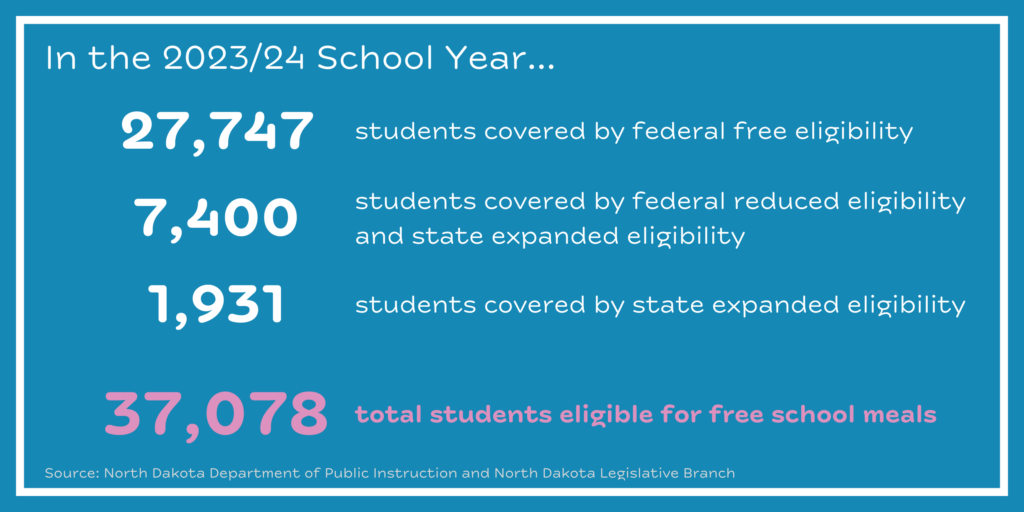
More families just above the eligibility level would benefit from access to healthy school meals at no cost. For example, a family of four with a 4-year-old and an 8-year-old earning 225 percent of poverty (about $72,000 per year) doesn’t earn enough to pay for necessities, according to the Economic Policy Institute’s Family Budget Calculator.14 Fortunately, policymakers this session did include a one-time $6 million appropriation in the Department of Public Instruction budget (House Bill 1013) for school meals, covering free meals for families up to 225 percent of poverty. This limited expansion represents a win for families most in need but ultimately fell short of a bigger impact across the state. Two bills were introduced to expand healthy school meals for all.
House Bill 1475 and House Bill 1553 would have invested $140 million in state funds to cover healthy school meals for all students, a policy implemented in nine other states that has been proven to support improved education outcomes, reduce food insecurity, and improve nutrition.15,16 More than 50 proponents provided testimony for the first hearing on House Bill 1475, but ultimately, both bills failed to pass the House. The primary difference in each bill was the source of funding, with House Bill 1475 appropriating money from the general fund and House Bill 1553 from the Legacy Fund.
Two other bills passed that aimed to improve food security by investing state funds in food infrastructure, like expanding the Great Plains Food Bank capacity and supporting rural grocery stores.
- House Bill 1143 provides a $5 million investment in a food distribution facility, which would expand the capacity of Great Plains Food Bank to provide more food to more people across North Dakota.17
- Senate Bill 2390 appropriates $2.5 million toward a rural catalyst grant program, which can be used for projects in rural communities, including re-opening rural grocery stores. While not directly aimed at food insecurity, this investment has the potential to support rural communities’ food security efforts depending on grant recipients.
Promising Progress: Indian Child Welfare Act (ICWA) and Some Tribal Efforts Strengthened
During the 2023 session, lawmakers voted unanimously to pass a state-based Indian Child Welfare Act (ICWA). ICWA is a federal law that prevents the unwarranted removal of American Indian children from their homes and keeps them connected to their families and culture when possible. Experts and practitioners at national child welfare agencies agree that ICWA is the gold standard because it promotes the best interests and unique needs of American Indian children.18 ICWA addresses and repairs past harm Tribal communities endured through decades of harmful policies where the federal government intentionally separated American Indian families, trying to assimilate them into the dominant culture and beliefs.
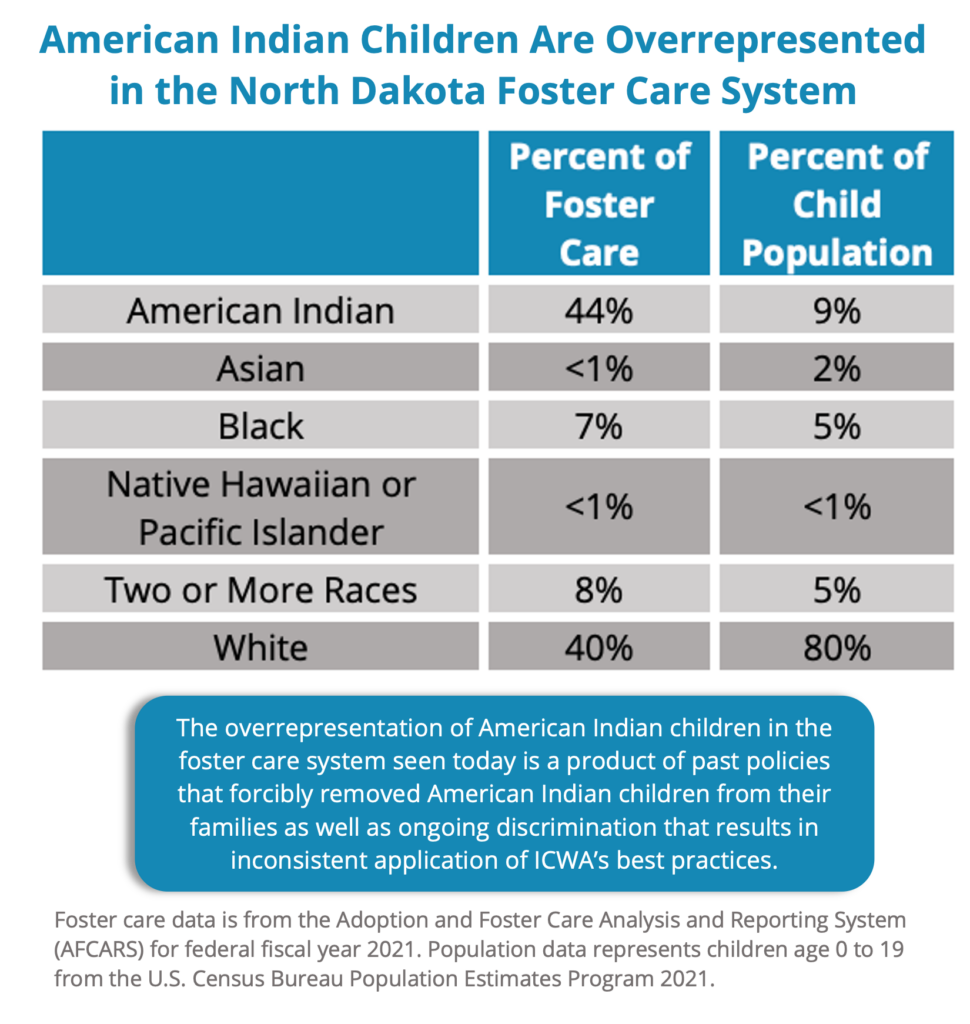
While the Supreme Court case that threatened ICWA in 2023 ultimately upheld its constitutionality, state protections remain important in a federal ICWA landscape that continues to be challenged.19 This session, legislators passed House Bill 1564, which strengthens the North Dakota ICWA program established last session. Changes include:
- Clarifying language that led to confusion on implementation, like removing the term “non-foster care placement,” which isn’t universally used.
- Refines the definition of active efforts to require proactive actions to prevent the unwarranted removal of American Indian children.
- Strengthens the notification process to parents, custodians, and Tribes.
- Solidifying placement preferences for Indigenous children by prioritizing extended family, other Tribal members, or other Indigenous families.
- Requires adoptive placement records be shared with the Bureau of Indian Affairs to preserve a connection to Tribal affiliations and membership eligibility.
House Bill 1072 also made minor changes to foster care policies, clarifying that guardianship with family or kin (an alternative to a foster placement) can use state funds if ineligible for federal. This clarifies in code what is already in practice in North Dakota and ensures that guardianship with family or kin remains a viable option when applicable.
Another priority impacting Indian Country is how the state is addressing the disproportionately high number of missing and murdered Indigenous people. House Bill 1199 creates the Missing and Murdered Indigenous Persons Task Force and appropriates $250,000 to a grant fund to support Tribal efforts to find missing Indigenous people. The Task Force will submit an annual report including outcome data relevant to evaluating the ongoing efforts and needs.
Mixed Bag: Child Care Worker Program Fails, but Overall Child Care Funding Sees Increase
North Dakota has been a regional leader in child care, investing a historic $66 million during the last biennium to help make child care more affordable for families. For the upcoming biennium, much of the one-time funding approved last session was included in the baseline operating budget for child care programs. Those investments have made a big difference for families:
- More families are participating in the Child Care Assistance Program, with 4,200 families and 6,890 children participating in February 2025, a 91 percent increase in children benefitting since February 2022.20
- Child care workers are now eligible for Child Care Assistance if working 25 hours a week or more, a proven recruitment and retention tool for workers who also have young children.
- Child care providers saw an increase in the rates for Child Care Assistance, increasing the rate a center receives for an infant by 40 percent.21,22
An additional one-time appropriation of $21.9 million was included in the overall Department of Health and Human Services Budget (House Bill 1012) to support early childhood education and child care. Additionally, four other bills passed related to child care:
- Senate Bill 2282 provides a tax credit for employers who contribute to a licensed child care program on behalf of their employees. The credit is limited to $1,000 and is equal to 50 percent of the contributions, essentially providing a maximum $500 credit per employee.
- House Bill 1119 requires an interim study on child care services and licensing and creates a child care licensing advisory committee. The original bill proposed changes to the licensing framework, including removing the group child care and school age categories. The ultimate goal is to streamline the licensing process and reduce administrative burden. The study requires input from child care providers, who have an important voice to provide feedback on changes.
- Senate Bill 2107 made a minor change to how training credits are applied to licensing. It ensured that training completed during a license renewal would count toward the next fiscal year, giving child care workers a full 12 months to complete annual training.
- House Bill 1497 made a minor change to the Best-in-Class program serving four-year-olds. Typically, a child must turn 4 by August 1st of the school year a program starts. This bill allows a child who turns 4 on December 1st of the program year to participate if they show readiness.
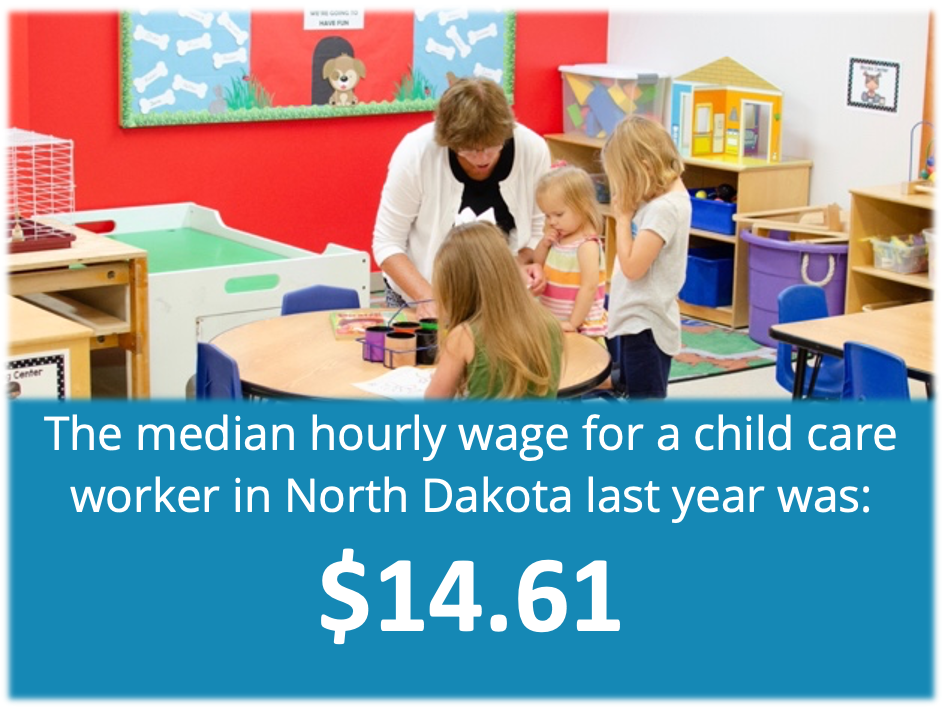
Similar to a bill introduced last session, Senate Bill 2306 would have created a child care workforce recruitment and retention program providing monthly grants to increase salary and benefits of child care workers. Unfortunately, this bill failed in the Senate with a vote of 11-36. In 2024, the median wage for a child care worker in North Dakota was $14.61, putting this profession in the bottom 20 occupations based on wages.23
Mixed Bag: Modest Progress Made on Some Health and Safety Initiatives
A few smaller bills passed that support health and safety initiatives for youth, but children’s health is an ongoing area of concern for children and young adults in North Dakota. During the 2023-2024 interim, the Human Services Committee studied mental health care for children, and in 2023, 35 percent of North Dakota high school students reported feeling sad or hopeless almost every day for two or more weeks in the last year.24 However, only one bill moved forward related to supporting youth mental health.
- Senate Bill 2200 appropriates $500,000 from the community health trust fund to support the 988 Suicide and Crisis Lifeline over the next biennium. Youth use the 988 services, particularly after text and chat options were added in, with 31 percent of 988 calls, chats, and texts coming from youth and young adults (those age 24 and younger).25
Other bills related to children’s health largely focused on access to medical services. The health insurance landscape has shifted dramatically in the last two years, with the end of the Medicaid continuous enrollment provision enacted during the pandemic. Fortunately, North Dakota has a low rate of uninsured children still, with only an estimated 4 percent of children lacking health insurance.26
- House Bill 1067 made small changes to the Medicaid program relating to youth. In-home services to children diagnosed with autism spectrum disorder were expanded to 19- and 20-year-olds.
- House Bill 1567 proposes an interim study on access to oral and dental health care for low-income children, American Indian children, and individuals with disabilities. This study was selected for the 2025-2026 interim.
- House Bill 1464 would have defined postpartum doula services and required medical assistance to cover the service. This bill was amended to a legislative management study on maternal care services, but ultimately did not pass in this form.
Two final bills worth highlighting related to children’s safety:
- House Bill 1562 updates the requirements for mandatory reporter training for teachers. Instead of annually, teachers are now required to complete mandatory reporter training at their initial licensure and with each renewal (every five years). This updated frequency was discussed as a compromise to alleviate the burden of annual training. This bill also added language for school districts to include child abuse and neglect training in the professional development program.
- House Bill 1095 created a child safety liaison work group, which is intended to facilitate coordination and efforts among Human Service Zones and school districts.
Missed Opportunity: Family Economic Security Policies Fail to Pass
When compared to other states, North Dakota often fairs well in economic well-being for families; however, data consistently shows that many families still struggle to make ends meet. In 2023, 15,000 children lived below the poverty level, and in the same year, 27,000 children lived in families that paid more than 30 percent of their income on housing.27,28 While other bills overlap with family economic support (expanding access to free school meals for more families, maintaining investments in child care to help families), policymakers brought forward bills worth highlighting that would have expanded financial support to families that need it most.
House Continuing Resolution 3032 would have raised the minimum wage to $9.25 per hour (up from the current $7.25 per hour minimum wage, which is the same as the federal level) and included language for incremental cost-of-living increases each year. This resolution failed on the House floor 11-79. Thirty other states have minimum wages set at $10 or greater, a minimum amount shown to improve child and family outcomes.29 On average, workers in North Dakota do earn higher wages compared to other states. However, there are minimum-wage and low-wage workers in North Dakota, too. Raising the minimum wage ensures that even the lowest-paid occupations earn more than poverty-level wages.
Senate Bill 2030 would have made a state investment toward lessening homelessness across the state. This bill proposed $10 million in funding for homeless grants, $1 million in grants to homelessness liaison services in school districts, $200 million to the housing incentive fund, and $50,000 to support a legislative management study. This bill failed to pass out of the Senate. However, Senate Bill 2014 did include a legislative management study proposal on homelessness, which was selected during the 2025-2026 interim.
Stalled Progress: Continuous Attacks on North Dakota’s Public Education
In 2025, there were many attacks on public education in North Dakota, with proposals for Education Savings Accounts and bills that weakened education equity across the state. Two bills would have helped strengthen Native American education across all schools and specifically supported education at Tribal schools, but neither passed.
- House Bill 1536 proposed a $1.5 million investment to make progress on implementing the Native American history curriculum requirement passed during the 2021 session. This included funding to support curriculum development, teacher training, educational materials, and oversight. In addition to funding, House Bill 1536 would have established a Native American curriculum advisory committee. Unfortunately, House Bill 1536 failed to pass out of the House. While a smaller, one-time investment ($950,000) was included in the overall Department of Public Instruction budget related to the Native American Essential Understandings curriculum, this funding falls short of the broader need to develop and implement a Native American history curriculum in a way that honors Tribal engagement, provides educators the resources and training needed to implement lessons effectively, and ultimately creates a more inclusive education environment for Indigenous students.
- House Bill 1565 proposed a $1.7 million investment toward a non-beneficiary grant program, providing Tribal schools with per-student funding for non-Tribal children who are not eligible for federal funding. Without a program like this, Tribal schools are left to educate more children with fewer resources. House Bill 1565 failed to pass out of the House.
A bill like House Bill 1536 matters because one strategy for improving academic success for American Indian students is to incorporate more culturally based education into the curriculum. Unfortunately, disparities continue to exist for Black, Indigenous, and children of color for education outcomes. For example, 65 percent of American Indian students graduate high school in four years compared to 83 percent overall.30,31 Disparities like these are a product of generations of discrimination, chronically underfunded programs promised as part of treaties between the federal government and Tribal Nations, and lack of cultural representation in public schools. A school curriculum that includes American Indian culture, heritage, and history can help Indigenous students feel a sense of belonging and improve their academic success.32 Additionally, ensuring public schools and educators have the training and resources to fully implement Native American history curriculum is one way to foster a more culturally relevant education for the roughly 12,000 Indigenous students attending public schools in North Dakota.33
Two bills related to Education Savings Accounts were proposed but ultimately did not pass.
- House Bill 1540 and Senate Bill 2400 both proposed creating Education Savings Accounts, which would divert state dollars to families to use at private and religious schools. While proponents talked about this creating more choice for families, opponents cited that these accounts don’t translate to true choice for most families, and diverting resources away from public schools, where roughly 90 percent of North Dakota children attend, would weaken the public education system where every child is guaranteed an education held to statewide standards.34 Ultimately, both bills failed, Senate Bill 2400 in the House and House Bill 1540 by the Governor’s veto. In other states that implemented similar policies (Education Savings Accounts or vouchers), academic performance is worse for students receiving a voucher, and most vouchers go to students already attending a private school.35,36
Numerous other bills were introduced that threatened education equity in North Dakota. Not every bill passed, but all reflect a growing trend toward policies that create exclusionary conditions for Indigenous and LGBTQ+ students.
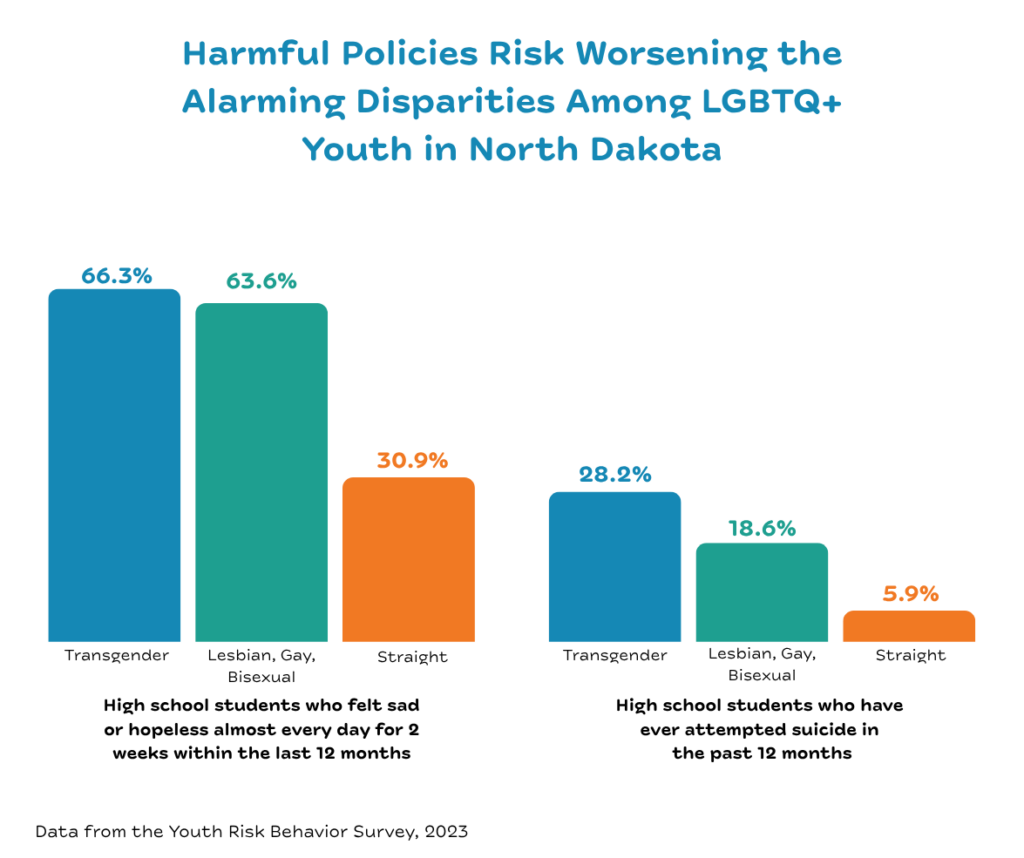
- House Bill 1144 further restricts access to restrooms for transgender and gender nonconforming students that align with their gender identity and prevents schools from creating guidelines for preferred pronoun use. Both restrictions create less inclusive school environments for LGBTQ+ youth, who experience numerous disparities in their mental health and exposure to bullying.37 House Bill 1144 was signed into law by the Governor.
- House Bill 1181 defines gender as the individual’s sex, again creating less inclusive environments for trans youth across the state. The original bill also included language to require pronouns to match an individual’s sex at birth but was amended out of the final version. House Bill 1181 was signed into law by the Governor.
- Senate Bill 2244 makes numerous changes to parental rights, including parent notification of any instruction related to gender identity and sexual orientation and requiring parent consent to use a name or pronoun not aligned with a child’s sex at birth. Senate Bill 2244 passed the Senate but failed to pass in the House.
- Senate Bill 2392 was a broad bill that attempted to limit the types of content that can be taught in public schools and higher education programs, including limiting diversity, equity, and inclusion initiatives. Ultimately, Senate Bill 2392 did not pass out of the Senate
On a more positive note, Senate Continuing Resolution 4019 proposed studying reading and math proficiency rates among students with disabilities, and this study was selected for the 2025-2026 interim. At a time when reading and math proficiency have declined with disruptions to education from the pandemic, making proactive efforts to understand how to support students’ learning best is hopeful for many students and families across the state.
While the 2025 session has wrapped up, the work to advocate for stronger policies for children continues. State agencies administering programs have a wide range of authority to make rules at the state level that would better support families. North Dakota’s 2025-2026 interim will also be filled with committee work that sets up discussions for the 2027 session.
Footnotes
- North Dakota Legislative Branch, “69th Legislative Assembly (2025-2027), Bills & Resolutions Index,” accessed on June 12, 2025.
- Legislative Council, “69th Legislative Assembly State Budget Actions for the 2025-27 Biennium (Including Supplemental and Statistical Information Regarding the State Budget),” June 2025.
- Legislative Council, “68th Legislative Assembly State Budget Actions for the 2023-25 Biennium (Including Supplemental and Statistical Information Regarding the State Budget),” June 2023.
- Legislative Council, “Statement of Purpose of Amendment, House Bill No. 1012 – Funding Summary.”
- North Dakota 68th Legislature, SB 2012 (Appropriations Committee), enacted on May. 18, 2023.
- Gee, M., Department of Health and Human Services, Economic Assistance Section, “Engrossed HB 1012 Overview – Economic Assistance,” Senate Appropriations Committee, Human Resources Division, Mar. 31, 2025.
- Aker, S., Department of Health and Human Services, Medicaid Services, “House Bill 1012,” Senate Appropriations Committee, Human Resources Division, Mar. 12, 2025.
- The Children and Family Services budget was not decreased compared to the prior biennium but saw a $2 million increase. However, the Governor’s budget proposal requested a $20 million increase to cover anticipated foster care caseload from policy changes. This resulted in and “underfunded” budget, which appears in HB 1012 as a decrease.
- Legislative Council, “Statement of Purpose of Amendment, House Bill No. 1013 – Funding Summary.”
- North Dakota 68th Legislature, SB 2013 (Appropriations Committee), enacted on May 18, 2023.
- Great Plains Food Bank, “About Us, 2024 Annual Report, A letter from our CEO & Board Chair,” accessed on June 12, 2025.
- Feeding America, Map the Meal Gap, “Food Insecurity among the Child Population in North Dakota,” 2023.
- North Dakota KIDS COUNT, “The Impact of School Meals on Communities,” Oct. 2024.
- Economic Policy Institute, “Family Budget Calculator,” accessed on June 12, 2025.
- Food Research & Action Center, “Raise Your Hand For Healthy School Meals for All,” accessed on June 16, 2025.
- Food Research & Action Center, “School Meals are Essential for Student Health and Learning,” May 2021.
- Sobolik, M., Great Plains Food Bank, Testimony on HB 1143, Senate Appropriations Committee on Taxation, Mar. 31, 2025.
- National Indian Child Welfare Association, “Top 10 ICWA Myths Fact Sheet,” Feb. 2025.
- Lewerenz, D., Testimony on HB 1564, Senate Human Services Committee, Mar. 12, 2025.
- Department of Health & Human Services, “Child Care Assistance Program,” accessed on June 12, 2025.
- Department of Health & Human Services, “North Dakota Child Care Assistance Program Sliding Fee Schedule Effective Oct. 1, 2022,” on file with author.
- Department of Health & Human Services, “State Provider Rates (Effective July 1, 2024).”
- U.S. Bureau of Labor Statistics, “Occupational Employment and Wage Statistics,” May 2024.
- KIDS COUNT Data Center, “High school students feeling sad or hopeless in North Dakota,” 2023.
- Sagness, P., “Study of Mental Health Care for Children,” given to the Interim Human Services Committee, Apr. 8, 2024, on file with author.
- KIDS COUNT Data Center, “Children without health insurance by age group in North Dakota,” 2023.
- KIDS COUNT Data Center, “Children in poverty in North Dakota,” 2023.
- KIDS COUNT Data Center, “Children living in households with a high housing cost burden in North Dakota,” 2023.
- Prenatal-to-3 Policy Impact Center, “Prenatal-to-3 State Policy Roadmap: State Minimum Wage,” 2024.
- KIDS COUNT Data Center, “Four-year high school cohort graduation rate by race and ethnicity in North Dakota,” 2022/23.
- KIDS COUNT Data Center, “Four-year high school cohort graduation rate in North Dakota,” 2022/23.
- Smoker Broaddus, M., “The Importance of Providing Native American Education for All Students,” Dec. 2019.
- Insights North Dakota, “State Summary (2023-2024), accessed on June 12, 2025.
- National Center for Education Statistics, “Digest State Dashboard: North Dakota,” last updated May 2024.
- Cowen, J., “Research on school vouchers suggest concerns ahead for education savings accounts,” Brookings, Aug. 15, 2023.
- Cowen, J., “School Vouchers: There Is No Upside,” Albert Shanker Institute, Feb. 21, 2023.
- Seidler, F., “North Dakota State of the State Report for LGBTQ+ Youth,” 2025.

